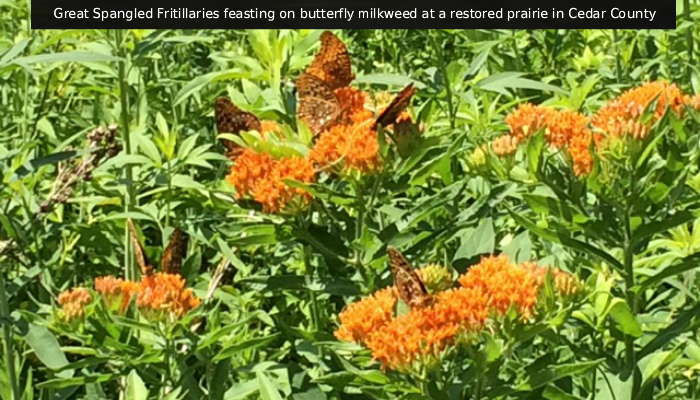Butterflies and Rabbits: a Gardening Struggle for Me at Mid-Summer

I really should not complain because the rains have come at just perfect spacing, the sunshine between has been ample (as has the heat), and the bugs are not bad at all (except for the chiggers, which have newly adopted me as a prime feasting opportunity). The hostas don’t have their usual big holes by mid-July and the raspberries produced well in spite of being trimmed late, weeded late, and not fertilized. Everything has grown like mad. But one of my big motivators to garden has been to attract butterflies.
Butterflies in my garden have really declined in number. I did not see one Monarch last year and not many other butterflies. This year I’ve seen two Red Admirals (they always seem to dance in pairs around here), one Tiger Swallowtail, one Giant Swallowtail (I think), and one Monarch. If it’s the same guy, I’ve seen him twice. (It’s true, I’m not in the garden ALL of the time!) And last year I had a hard time spotting any milkweed along roads or even in restored prairies, including ours. This year I see milkweed often, maybe partly due to widespread publicity about its decline.
At least in the Midwest, gardeners and citizens are being encouraged to help “Save the Monarchs” by planting a lot of pollinator flowers (coneflowers are biggies) and flowering shrubs for them to feast on, and planting milkweed (many different varieties) so that they can lay their eggs there. When the Monarch eggs hatch into caterpillars, they eat only the milkweed leaves; then they spin a chrysalis and transform into butterflies. (In checking this out online, I learned ALL butterflies have their own special plant required by their babies).
To help the effort, all are encouraged to plant milkweed. Two years ago, it was not easy to get these plants. Then “Save the Monarchs” became a major theme at the Hickory Hill Plant Sale, and they had lots of little plants for sale. This year I have even seen them for sale in garden centers. Two years ago, I dutifully bought and planted the little green wisps and managed to get three to survive; this year I’ve got about ten plants. Reward: two days ago I saw my Monarch landing on the milkweed, seeming at least to acknowledge its existence. I’ve inspected the leaves for eggs, but haven’t found any yet. But acknowledgement is a start. Last week when we visited my sister-in-law, her Monarch did the same thing, inspect her thriving milkweed patch! I was so envious, but WHEW, I can now at least be even with her!
I have always planted flowers to attract butterflies; red zinnias I know are a favorite, but it’s hard for me to find enough sunlight for them to thrive. The butterfly bush is a sure attraction, but it is not yet in bloom. I even applied online to the Blank Park Zoo in Des Moines to be a Certified Pollinator, to see if I was planting the right plants, and, well, also to get a certificate stating my garden is certified. I was planting all of the right things, but the butterflies have not been duly attracted to my plants OR impressed by my Certified Pollinator Habitat #716 Certificate.
One thing I learned about Iowa’s efforts recently, which somewhat amazed and amused me: on RAGBRAI (the yearly bicycle trek across the state, always by a different route of country roads and towns), cyclists have the option to pick up balls of dirt impregnated with milkweed seeds and throw them out along the route as they go! Very clever – although a desperate, partial solution – that plant and insect lovers have initiated and encouraged.
I have 16 plants that are supposed to appeal to butterflies and were sufficient for granting me that certificate. Although it has been a fine growing year, I, for the first time, have had four of the key butterfly attractor plants ruined by rabbits, including purple coneflowers and Black-eyed Susans, both usually in ample and full bloom right now. And other plants have succumbed, too. The area I saved for colorful annuals is now strewn with white plant markers, which are like roadside shrines memorializing the nibbled off attempts to add a little color with annuals. Most of those newly planted annuals just disappeared, tender little feasts for the bunnies. According to the nursery, the little ones are the worst, just trying out and tasting everything. What a struggle! Rotten egg spray, dried coyote blood, Irish Spring Soap shavings – all to little avail. I wrapped some old chicken wire around the surviving white Balloon Plant, and so far that has worked. Top of the gardening list is to put up more fencing.
Maybe Blank Park Zoo will take my certificate away!
Top causes of pollinator (bees and other bugs) and butterfly decline: loss of habitat due to more land constantly being covered with cement or blacktop, more land being developed into homes and apartments, more land being cultivated, more insecticide being used. Also, there is loss of foraging habitat for the rabbits, which makes them voracious consumers of my flowers. I can partly blame that on our neighbors for NOT having a vegetable garden this year – the usual big magnet – and the new apartments next door to us, which cover much more area than the old ones torn down to build them.
Yes, I’ve had my troubles. But I share them in the hopes that other people’s gardening and conservation efforts will help stop the serious decline in butterfly populations. Maybe one day I’ll again see, as I did 25 years ago, 20 monarchs landing on my autumn Sedum as they migrate through town. And we’ll all be able to enjoy these flying specks of summer color flitting about our gardens.


